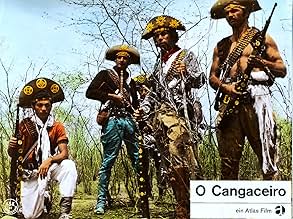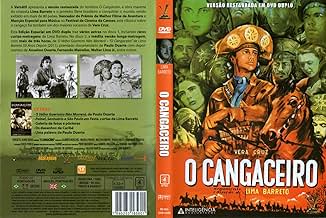Adicionar um enredo no seu idioma'Capitão', a bandit, terrorizes poor villages in the Northeast region of Brazil, looting and frequently killing with his armed gang, until he kidnaps and becomes attracted to a beautiful sch... Ler tudo'Capitão', a bandit, terrorizes poor villages in the Northeast region of Brazil, looting and frequently killing with his armed gang, until he kidnaps and becomes attracted to a beautiful schoolteacher, creating discord in his group.'Capitão', a bandit, terrorizes poor villages in the Northeast region of Brazil, looting and frequently killing with his armed gang, until he kidnaps and becomes attracted to a beautiful schoolteacher, creating discord in his group.
- Direção
- Roteiristas
- Artistas
- Prêmios
- 2 vitórias e 1 indicação no total
Avaliações em destaque
Another great film that is characterised by a memorable music score. Not all films with great music are great films, but haunting or otherwise memorable scores are a feature of so many of the greatest films of all time - The Third Man, Jeux Interdits, High Noon, American Graffiti, most of the Kubrick opus, Who's Afraid of Virginia Woolf and probably any documentary adopting Philip Glass' minimalism (The Thin Blue Line and The Fog of War) being prominent examples. This is so even when the music is not original but simply selected and edited in from classical music, popular or folk songs, as appropriate and evocative. Bets are that you won't be able to get the title folk song of O Cangaceiro out of your head for some time after you've finished watching it - it seems to affect every viewer that way.
This is a film reminiscent of The Wages of Fear, in its portrayal of poverty and the brutality, especially towards women, traditionally endemic in South America. No wonder Claude Levi-Strauss entitled his seminal ethnographic work based on travels in South America "Tristes Tropiques".
I had been warned of the brutality of the horse-dragging scene in this film - yet I can only say that it pales into insignificance with the graphic closing horse-dragging scene of The Cowboys - when I guess John Wayne was, as his career closed, ever more drawn to reactionary law-and-order neanderthalism.
A melancholic film with great B/W cinematography and even better music, depicting that eternal South American atmosphere of brutality and tragic sadness. A rare film well worth watching.
This is a film reminiscent of The Wages of Fear, in its portrayal of poverty and the brutality, especially towards women, traditionally endemic in South America. No wonder Claude Levi-Strauss entitled his seminal ethnographic work based on travels in South America "Tristes Tropiques".
I had been warned of the brutality of the horse-dragging scene in this film - yet I can only say that it pales into insignificance with the graphic closing horse-dragging scene of The Cowboys - when I guess John Wayne was, as his career closed, ever more drawn to reactionary law-and-order neanderthalism.
A melancholic film with great B/W cinematography and even better music, depicting that eternal South American atmosphere of brutality and tragic sadness. A rare film well worth watching.
I keep a very impressing souvenir of this picture I saw (6 times) in the fifties and would extremely appreciate if anyone could help me in finding a video copy. I much appreciated the crude and natural poetry of the film and,of course, the wonderful music. The photography also impressed me quite a lot and in my opinion Lima Barreto could have been influenced by Carol Reed. By all means, this film can certainly compete with the best "westerns" and should be given a chance to touch the actual generation by means of video, DVD etc. Although, since then, we have larger screens and color, this kind of picture in black and white proves, if necessary, that masterpieces exists without that.
O Cangaceiro is a great film, with great artists and great songs. We can see a young Vanja Orico singing "Sodade Meu Bem Sodade", a composition by Zé do Norte, an extraordinary Brazilian composer. Now we can hear his songs through his son, the singer Toninho Di Lita, who makes another extraordinary performance, singing with his wife Inajara De Tanduí and his group Bando do Galo Doido, with great singers and musicians like Elísio Paschoal(Hermeto Pachoal's brother), Eliane Carneiro, Chaguinha Lima(Siri Atômico Band), Guto(Siri Atômico Band), Teresa Carvalho(Dama de Paus) and Will Tom(Dama de Paus), who sang with John Phillips in a Tour in Brazil. Toninho Di Lita is a great presence on theaters of Rio de Janeiro, singing songs made by his father and a lot of his own compositions. With new musical cloths Toninho Di Lita sings "Sodade Meu Bem Sodade", "Meu Pião", "Mulher Rendeira" and some hits of his own. "Manto Negro" is a beautiful composition who explains about the personality of the death. Toninho is always worried about education so he also makes performances to Universities and to Public Schools. More about him we can see on "www.orkut.com" - Toninho Di Lita. He is very nice with his fans.
Beautifully photographed, this Brazilian variation on the western is a strange mix. On the positive sides the images are very striking, and there are scenes of emotional intensity and violence, especially around the film's climax that are amazingly well staged and acted.
On the other hand, there's not a lot of depth to any of the characters or their motivations. They're more archetypes than full people. (It also falls into that cliché of the better looking an actor is, the better human being his character is.) Certainly that's common in this genre, but it doesn't mean I have to like it.
The story is nothing that new. Yet it's presented with a fierceness and focus that makes it very watchable. These bandit anti-heroes are hard men with hard hearts. Their violence is still disturbing, even by modern standards.
The much discussed music fell on both sides of the fence to me. The score, which includes a lot of songs, is sometimes quite a haunting partner to the striking images. But at other times, when the group of bandits whose story this is fall into singing and dancing in ways that feel more akin to a musical than a gritty, violent western, the effect was odd and disconcerting, almost unintentionally comic. But that might just be a cultural bias - it took me a while to get used to the musical numbers in Bollywood films, for example.
Overall, this was a film I was glad I got to see, and would like to see again for its imagery. Also, now that I understand its style, some of the cultural quirks would be less likely to throw me off balance.
On the other hand, there's not a lot of depth to any of the characters or their motivations. They're more archetypes than full people. (It also falls into that cliché of the better looking an actor is, the better human being his character is.) Certainly that's common in this genre, but it doesn't mean I have to like it.
The story is nothing that new. Yet it's presented with a fierceness and focus that makes it very watchable. These bandit anti-heroes are hard men with hard hearts. Their violence is still disturbing, even by modern standards.
The much discussed music fell on both sides of the fence to me. The score, which includes a lot of songs, is sometimes quite a haunting partner to the striking images. But at other times, when the group of bandits whose story this is fall into singing and dancing in ways that feel more akin to a musical than a gritty, violent western, the effect was odd and disconcerting, almost unintentionally comic. But that might just be a cultural bias - it took me a while to get used to the musical numbers in Bollywood films, for example.
Overall, this was a film I was glad I got to see, and would like to see again for its imagery. Also, now that I understand its style, some of the cultural quirks would be less likely to throw me off balance.
In the times of the "cangaceiros" in the "sertão" (backcountry) in the North and Northeastern of Brazil, the cruel Capitão Galdino Ferreira (Milton Ribeiro) and his band abduct the school teacher Olívia (Marisa Prado), expecting to receive a ransom for her. However, one of his men, Teodoro (Alberto Ruschel) falls in love and flees with her through the arid backcountry chased by the brigands.
Along their journey, Olívia also falls in love with Teodoro and proposes him to leave the countryside and move to the city. But Teodoro loves also his land and tells that he would like to die in the backcountry where he was born.
"O Cangaceiro" is one of the best films of the Brazilian Cinema and the best produced by the Companhia Cinematográfica Vera Cruz. This film was written and directed by Lima Barreto, with dialogs of Rachel de Queiroz and is inspired in the story of the brigand Lampião and his band (http://en.wikipedia.org/wiki/Lampi%C3%A3o). The awesome cinematography in black and white discloses a magnificent introduction with backlight in the marauders.
On 12 May 1953, "O Cangaceiro" won the Cannes Film Festival in the category Best Adventure. In the wonderful soundtrack, highlights "Olê Muié Rendeira", sung by Vanja Orico. In accordance with the Wikipedia, this film was distributed by Columbia Pictures and sold to eighty (80) countries. It was exhibited in France for five consecutive years in the movie theaters. My vote is ten.
Title (Brazil): "O Cangaceiro" ("The Brigand")
Along their journey, Olívia also falls in love with Teodoro and proposes him to leave the countryside and move to the city. But Teodoro loves also his land and tells that he would like to die in the backcountry where he was born.
"O Cangaceiro" is one of the best films of the Brazilian Cinema and the best produced by the Companhia Cinematográfica Vera Cruz. This film was written and directed by Lima Barreto, with dialogs of Rachel de Queiroz and is inspired in the story of the brigand Lampião and his band (http://en.wikipedia.org/wiki/Lampi%C3%A3o). The awesome cinematography in black and white discloses a magnificent introduction with backlight in the marauders.
On 12 May 1953, "O Cangaceiro" won the Cannes Film Festival in the category Best Adventure. In the wonderful soundtrack, highlights "Olê Muié Rendeira", sung by Vanja Orico. In accordance with the Wikipedia, this film was distributed by Columbia Pictures and sold to eighty (80) countries. It was exhibited in France for five consecutive years in the movie theaters. My vote is ten.
Title (Brazil): "O Cangaceiro" ("The Brigand")
Você sabia?
- CuriosidadesThe very first Brazilian film to compete at the Cannes Film Festival.
- ConexõesEdited into A Edição do Nordeste (2023)
Principais escolhas
Faça login para avaliar e ver a lista de recomendações personalizadas
Detalhes
- Tempo de duração1 hora 45 minutos
- Cor
- Mixagem de som
- Proporção
- 1.37 : 1
Contribua para esta página
Sugerir uma alteração ou adicionar conteúdo ausente

Principal brecha
By what name was O Cangaceiro (1953) officially released in India in English?
Responda




















